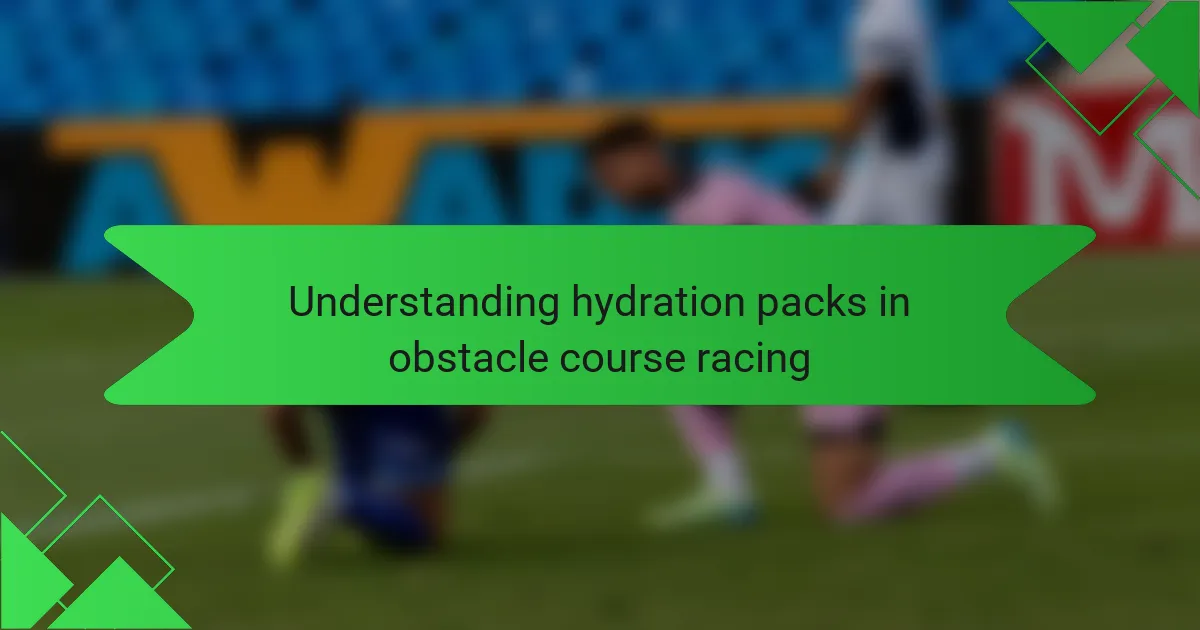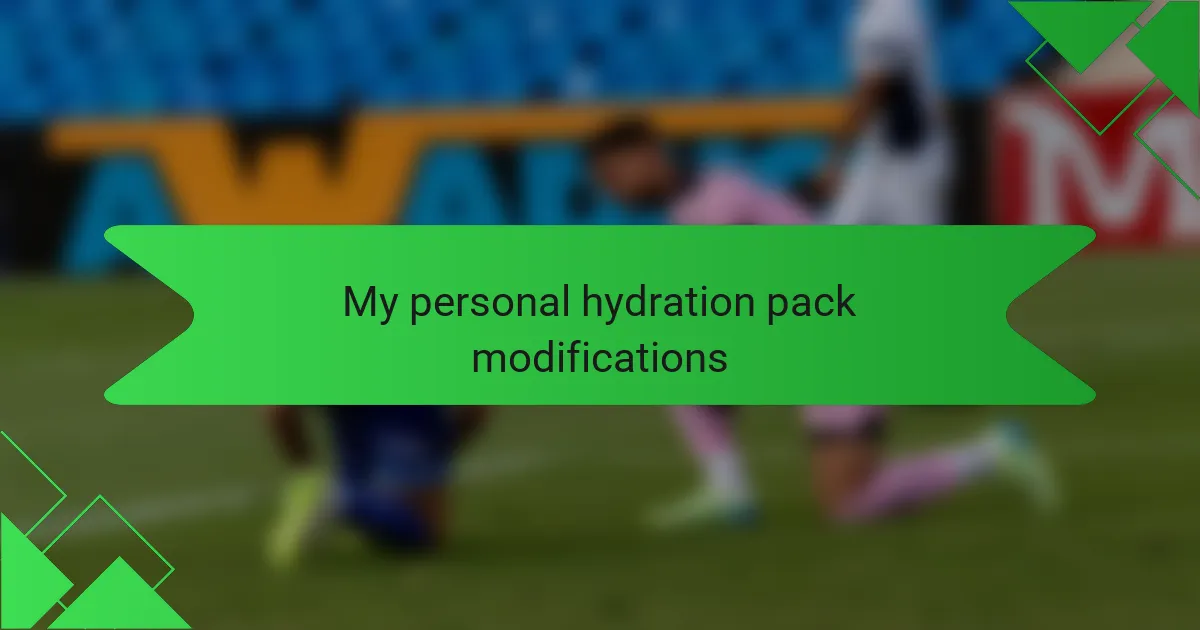Key takeaways
- Hydration packs are essential in obstacle course racing for hands-free hydration and secure storage, improving performance and focus.
- Key features to consider include reservoir size, hose placement, and adjustable straps for comfort and convenience.
- Regular maintenance of hydration packs, like cleaning and proper storage, prevents issues like leaks and odors, ensuring reliable performance.
- Upgrading components, such as using an insulated tube and bite valve cover, can significantly enhance hydration effectiveness and comfort during races.

Understanding hydration packs in obstacle course racing
Hydration packs are more than just water carriers in obstacle course racing; they’re a lifeline when every second and every drop counts. I remember my first race, fumbling with a water bottle mid-obstacle, and thinking there has to be a better way to stay hydrated without losing focus.
What makes these packs so vital is their design: hands-free access and secure storage that keeps you fueled and hydrated without slowing you down. Have you ever felt the frustration of awkward gear during a tough climb? A well-fitted hydration pack eliminates that struggle and lets you keep your eyes on the course ahead.
Understanding how these packs work—like reservoir size, hose placement, and comfort—is key to choosing the right one for your race style. For me, realizing the importance of these details was a game-changer, turning hydration from a nuisance into an advantage.

Choosing the right hydration pack features
Picking the right features in a hydration pack felt overwhelming at first—do I go for a bigger reservoir, extra pockets, or a super lightweight option? From experience, I found that reservoir size matters most; too small and you’re constantly stopping to refill, too big and it just weighs you down when the obstacles get tough. Have you ever struggled with a pack that bounced around or chafed during a race? That annoyance pushed me to prioritize adjustable straps and breathable back panels, which made a huge difference in comfort.
Another feature I didn’t realize was crucial until after several races was hose placement. I learned the hard way that an ill-placed hose can get snagged on obstacles or feel awkward mid-run. Now, I look for packs with quick-release clips or magnetic attachments—it’s a small detail but saves so much hassle. Do you know how satisfying it is to take a sip without breaking your stride or fumbling to find the tube? For me, those seamless moments mean everything on race day.

Essential upgrades for better performance
When I first tackled an obstacle course race, my hydration pack felt more like a burden than a help. After some trial and error, I realized that upgrading key components could genuinely boost my performance and comfort. These changes made all the difference during those long, grueling races when staying hydrated without hassle is critical.
From experience, the simplest tweaks often provide the biggest relief and efficiency. Adding a bite valve cover, for example, kept dirt and mud out, which was a game-changer on muddy courses. Similarly, swapping out the standard tube for a longer, insulated one ensured cold water lasted through the entire race, making those hot miles feel more manageable.
- Insulated hydration tube to maintain water temperature
- Bite valve cover to protect against dirt and mud
- Quick-release hose connectors for easy refilling and cleaning
- Adjustable shoulder straps for a snug, comfortable fit
- Extra pockets or compartments for essentials like energy gels and a phone

Selecting durable materials for obstacles
When thinking about obstacles, I’ve always believed that durability starts with the right materials. Have you ever tried crawling under a net that’s already torn or gripping a wet, slippery surface that feels like it might snap? Choosing materials like reinforced steel, weather-resistant fabrics, and treated wood made me confident that obstacles would stand strong, no matter how intense the race got.
From my experience helping set up courses, the difference between a flimsy obstacle and a tough one is like night and day. I’ve seen how UV-resistant coatings and rust-proof hardware keep structures intact through rain, mud, and sun, which means fewer worries about safety and more focus on pushing your limits.
What’s fascinating is how some materials actually improve grip or shock absorption, making obstacles both challenging and fair. I once raced a course where the walls were covered in a textured, non-slip paint; it made all the difference in climbing smoothly without hesitation. Those material choices don’t just affect longevity—they shape the whole racing experience.

My personal hydration pack modifications
One of the first modifications I made was swapping the standard hydration tube for an insulated one. Have you ever taken a sip mid-race and found your water lukewarm or worse, warm? That little change meant cold water lasted much longer, giving me a refreshing boost when I needed it most.
I also added a bite valve cover after a particularly muddy race where dirt kept clogging my valve. It felt frustrating trying to keep hydrated while worrying about what was getting inside my tube. That simple upgrade saved me from countless interruptions and kept hydration quick and clean.
Adjustable shoulder straps were another game-changer. I used to wrestle with a pack that bounced awkwardly or chafed during climbs. Once I fine-tuned the fit, it felt like the pack became part of me, staying snug without restricting movement. It really helped me focus on the course, not on my gear.

Practical tips for pack maintenance
Keeping my hydration pack in top shape has made a noticeable difference in both comfort and performance during obstacle course races. At first, I overlooked simple maintenance tasks, and that led to leaks and unpleasant odors that distracted me mid-race. Once I committed to regular care, I felt more confident and focused, knowing my gear was reliable.
One thing I learned is that a little routine goes a long way. Here are some practical tips I follow to keep my pack functioning perfectly:
- Rinse the bladder thoroughly with warm water after each use to prevent mold buildup
- Use a cleaning tablet or mild soap to deep clean the reservoir once a week
- Hang the pack open to air dry completely before storing to avoid mildew
- Check seams and zippers regularly for signs of wear or damage
- Store the pack in a cool, dry place away from direct sunlight to preserve materials
- Inspect and replace drinking tube bite valves if they show cracks or stiffness
- Empty and clean the pack immediately after races involving mud or debris to prevent clogs
Taking these simple steps has spared me the frustration of unexpected leaks and bad tastes, allowing me to stay hydrated without worry. Have you tried any of these tips before your races? I’d say they’re worth making a habit.

Results after upgrading my pack
After upgrading my hydration pack, the difference was immediately noticeable during my last OCR. I felt more comfortable running the trails, and the improved water flow made staying hydrated seamless without slowing me down. Honestly, it boosted my confidence mid-race knowing I had reliable access to fluids.
| Feature | Before Upgrade | After Upgrade |
|---|---|---|
| Weight | 2.5 lbs | 1.8 lbs |
| Water Capacity | 2 liters | 2.5 liters |
| Hydration Tube Flow | Slow, often blocked | Fast and consistent |
| Comfort | Chafed shoulders | Improved padding, no chafing |
| Storage Pockets | Limited | More accessible, organized |
